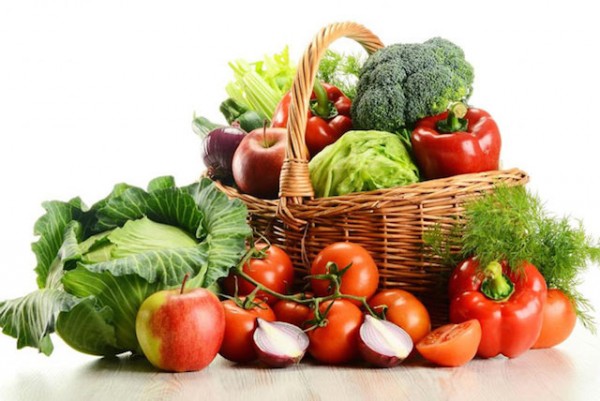
Advertisement
Cancer is one of the most prevalent maladies to plague modern society. Luckily, as with most illnesses, cancer is a mismatch disease – meaning it is a product of culture rather than biology; and there are plenty of steps you can take to stymie this nasty killer.
One of the best ways to thwart cancer is by eating a healthy diet. Unfortunately, there is a monsoon of conflicting information on the web about which foods have the most anti-cancer properties. It’s time to simplify. The following is an excerpt taken from Michio Kushi and Alex Jack’s book, The Cancer Prevention Diet, which breaks down what an anti-cancer diet should consist of, point by point.
SOUP
About 5 to 10 percent (one or two cups or bowls) of daily intake may be in the form of soup. Soup broth can be made with miso or shoyu (natural soy sauce), which are prepared from naturally fermented soybeans, sea salt, and grains, to which several varieties of land and sea vegetables, especially wakame or kombu (kelp), green vegetables, and occasionally shiitake mushroom, may be added during cooking. The taste of miso or shoyu should be mild, not too salty or too bland. Barley miso, rise miso, or all-soybean miso (hatcho miso), aged naturally two to three years, is recommended for regular use. Soups made with grains, beans, or vegetables can also be served from time to time. For instance, delicious seasonal varieties can be made, such as corn soup in the summer or squash soup in the fall.
VEGETABLE DISHES
About 25 to 30 percent of our daily food should be fresh vegetable dishes, which can be prepared in a wide variety of cooking styles: sauteing, steaming, boiling, blanching, deep-frying, marinating, and pressed and boiled salads. Among root and stem vegetables, carrots, onions, daikon (white radishes), turnips, red radishes, burdock, lotus root, rutabagas, and parsnips are excellent. When preparing root vegetables, cook both the root and leaf portions so as to achieve a proper balance of nutrients by using the whole food. Among vegetables from the ground, cabbage, cauliflower, broccoli, Brussels sprouts, Chinese cabbage, acorn squash, butternut squash, buttercup squash, and pumpkin are quite nutritious and may be used daily. Among green and white leafy vegetables, watercress, kale, parsley, leeks, scallions, dandelions, collard greens, bok choy, carrot tops, daikon greens, turnip greens, and mustard greens are fine for regular use. Vegetables for occasional use include cucumbers, lettuce, string beans, celery, sprouts, yellow squash, peas, red cabbage, mushrooms (various, including shiitake), kohlrabi, and others. In general, up to one-third of vegetable intake may be eaten raw in the form of fresh salad or traditionally prepared pickles. However, it is better to avoid mayonnaise and commercial salad dressings. Vegetables that originated historically in tropical or semitropical environments, such as eggplants, potatoes, tomatoes, asparagus, spinach, sweet potatoes, yams, avocados, green and red peppers, and other varieties, tend to produce acid and should be avoided or minimized unless you live in a hot and humid climate.
BEANS AND SEA VEGETABLES
From 5 to 10 percent of daily intake may be eaten in the form of cooked beans and sea vegetables. Beans for daily use are aduki (small red) beans, chickpeas, lentils, and black soybeans. Other beans may be used occasionally, two to three times a month: yellow soybeans, pinto, white, black turtle, navy, kidney, and lima beans, split peas, black-eyed peas, and others. Soybean products such as tofu, tempeh, and natto may be used daily or regularly in moderation and be considered part of the daily volume for this category. Sea vegetables are rich in minerals and should be used in small volume on a daily basis in soups, cooked with vegetables or beans, or prepared as a side dish. Wakame, kombu, and nori are usually used daily, while all other seaweeds, including arame and hijiki, may be used occasionally. These dishes may be seasoned with a moderate amount of shoyu, sea salt, or a grain-based vinegar, such as brown rice vinegar.
Fruit
Fresh fruit may be eaten a few times a week preferably cooked or naturally dried as a supplement or dessert, provided the fruits grow in the local climatic zone. Fresh fruits can also be consumed in moderate volume occasionally during their growing season. In temperate areas these include apples, strawberries, cherries, peaches, pears, plums, grapes, apricots, prunes, blueberries, blackberries, raspberries, cantaloupe, honeydew melon, watermelon, tangerines, oranges, and grapefruit. In these climates, avoid or curtail tropical or semitropical fruits such as bananas, pineapples, mangoes, papayas, figs, dates, coconut, and kiwis. In the areas in which they grow, these fruits may be eaten in small volume. Fruit juice is generally too concentrated for regular use (e.g., ten apples go into one glass of apple juice). However, occasional consumption in very hot weather is allowable, as is consumption of apple cider, preferably warmed, in the fall. Dried fruit may be eaten on occasion so long as it is from the same or a similar climatic region.
You can order a copy of Michio Kushi and Alex Jack’s book by clicking this link.
Sources include:
(1) Kushi, Michio; Jack, Alex. The Cancer Prevention Diet: The Macrobiotic Approach to Preventing and Relieving Cancer. St. Martin’s Press: New York, NY. 1993.
(2) Amazon.com
Advertisements







